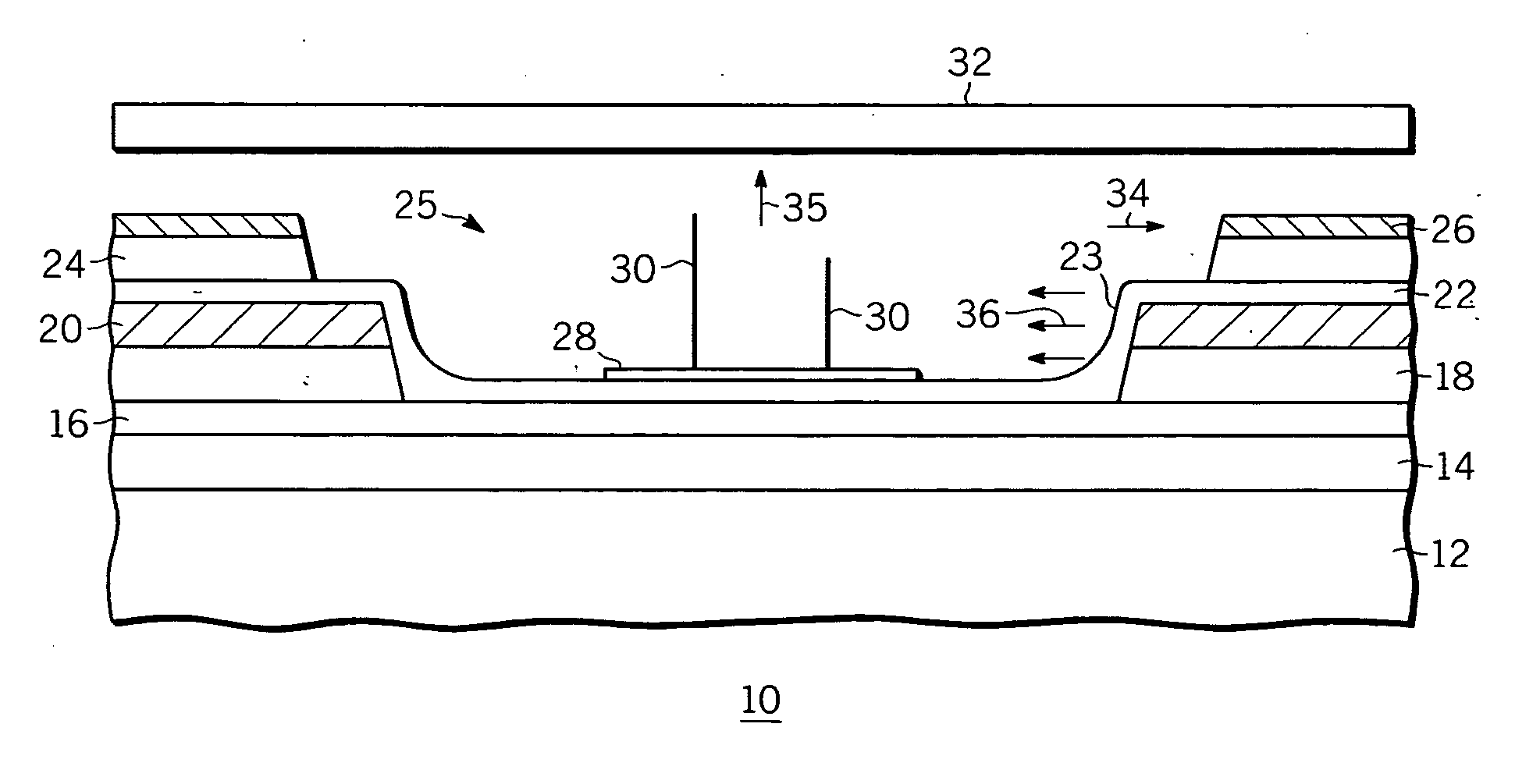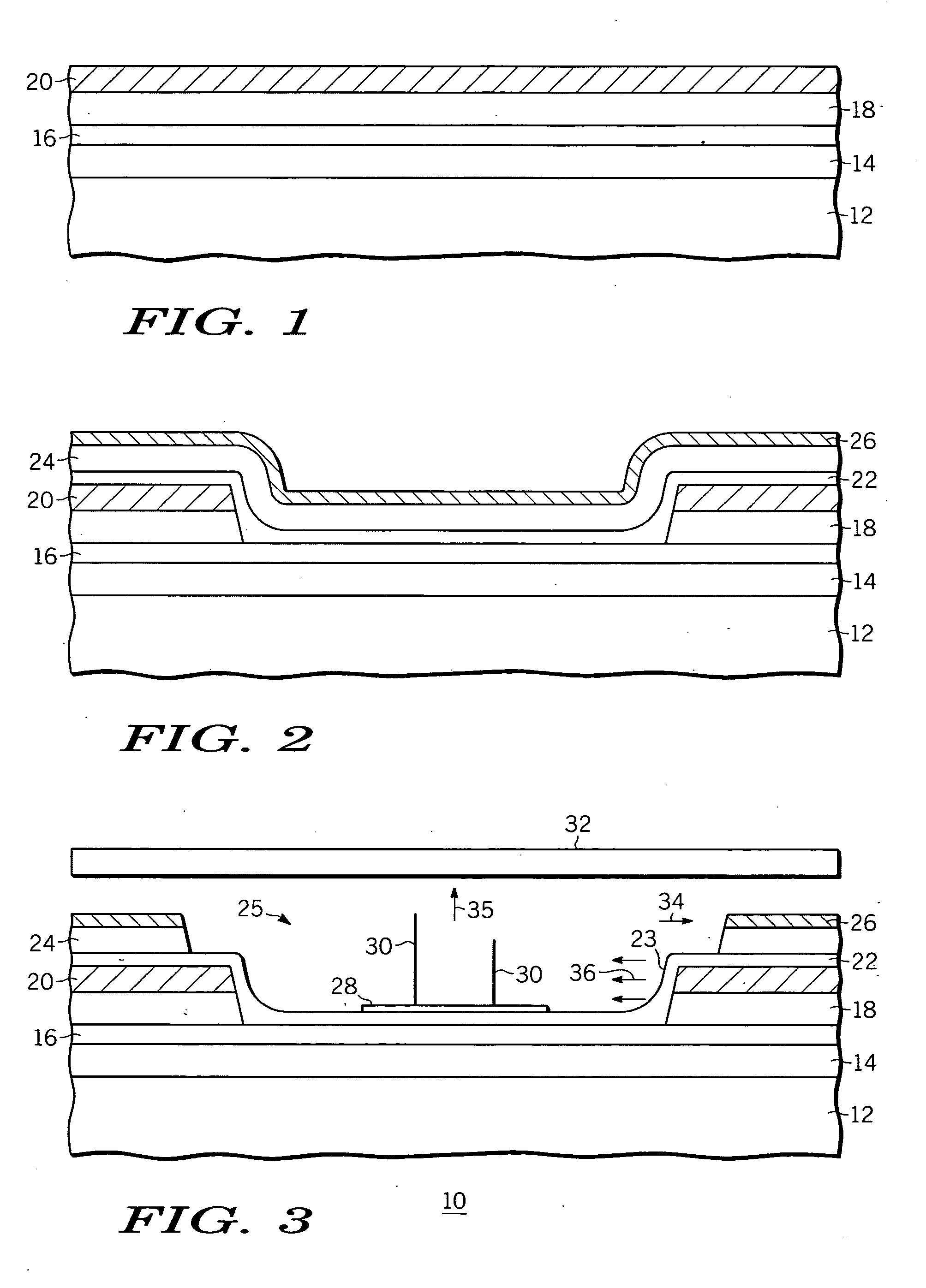Field emission display with electron trajectory field shaping
a field emission display and electron trajectory technology, applied in the manufacture of electrode systems, electric discharge tubes/lamps, discharge tubes luminescnet screens, etc., can solve the problems of increasing the power requirements of the device, unsatisfactory large spot size, and disadvantages of prior art focusing structures
- Summary
- Abstract
- Description
- Claims
- Application Information
AI Technical Summary
Benefits of technology
Problems solved by technology
Method used
Image
Examples
first embodiment
[0014] Referring to FIGS. 1-3, the field emission device 10 according to the present invention includes a dielectric layer 14 deposited on the substrate 12. The substrate 12, for example, comprises glass, silicon, or ceramic. The dielectric layer 14, for example, comprises silicon oxide and would preferably be approximately 1 micron thick. A hard mask 16 of diamond-like carbon or nitride of approximately 0.05-0.5 microns is deposited on the dielectric layer 14 and is used for a self-limiting etch stop to aid in fabrication of a trench structure. Another dielectric layer 18 of silicon oxide and approximately 0.1-2.0 microns thick is deposited on the hard mask 16. A metal layer 20 of molybdenum or copper, for example, and of sufficient thickness to limit the voltage drop over the length of the cathode metal, approximately 0.2-2 microns thick, is deposited on the dielectric layer 18.
[0015] Referring to FIG. 2, a photo etch is performed on the metal 20 and then on the dielectric 18 in a...
second embodiment
[0020] In a second embodiment, shown in FIG. 4, the first set of layers is ordered with cathode metal 44 on the bottom, a dielectric layer 45 in the middle, and the ballast layer 46 on top. A typical fabrication sequence would involve providing a substrate 41 with a barrier layers 42 deposited thereover (for example SiO2 or SiN), depositing a cathode metal layer 44, depositing a dielectric layer 45, depositing a photoresist, patterning and developing the photoresist, etching the dielectric layer 45 and then the cathode metal layer 44. The ballast layer 46 is deposited as the top layer, thereby covering the sidewall, and a dielectric layer 47 and a gate layer 48 are formed thereon. It is not patterned in the vicinity of the trench. The ballast sidewall height is desired to be at most 2× the emitter height, less the catalyst thickness. Emitters greater than 1.5× the total trench depth risk contacting the gate prior to biasing and becoming attached by Van der Waal's forces. The catalys...
third embodiment
[0021] In a third embodiment, shown in FIG. 5, the first set of layers is ordered with a thick cathode metal 52 on the bottom, and the ballast layer 53 on top. A dielectric layer is not used. A typical fabrication sequence would involve providing a substrate 51 with barrier layers on it of, for example, SiO2 or SiN, depositing a thick cathode metal layer 52, depositing a photoresist, patterning and developing the photoresist, etching the cathode metal layer 52. The ballast is deposited as the top layer, thereby covering the sidewall, and a dielectric layer 54 and a gate extraction layer 55 are formed thereon. The ballast sidewall height is desired to be at most 2× the emitter height, less the catalyst thickness.
[0022] This invention, in addition to focusing the electrons, also aligns the nanotubes perpendicular to the electric field lines. The presence of the sidewall layer 23 at near the cathode 20 potential directs the electric field lines to be more parallel to the substrate 12. ...
PUM
 Login to View More
Login to View More Abstract
Description
Claims
Application Information
 Login to View More
Login to View More - R&D
- Intellectual Property
- Life Sciences
- Materials
- Tech Scout
- Unparalleled Data Quality
- Higher Quality Content
- 60% Fewer Hallucinations
Browse by: Latest US Patents, China's latest patents, Technical Efficacy Thesaurus, Application Domain, Technology Topic, Popular Technical Reports.
© 2025 PatSnap. All rights reserved.Legal|Privacy policy|Modern Slavery Act Transparency Statement|Sitemap|About US| Contact US: help@patsnap.com



